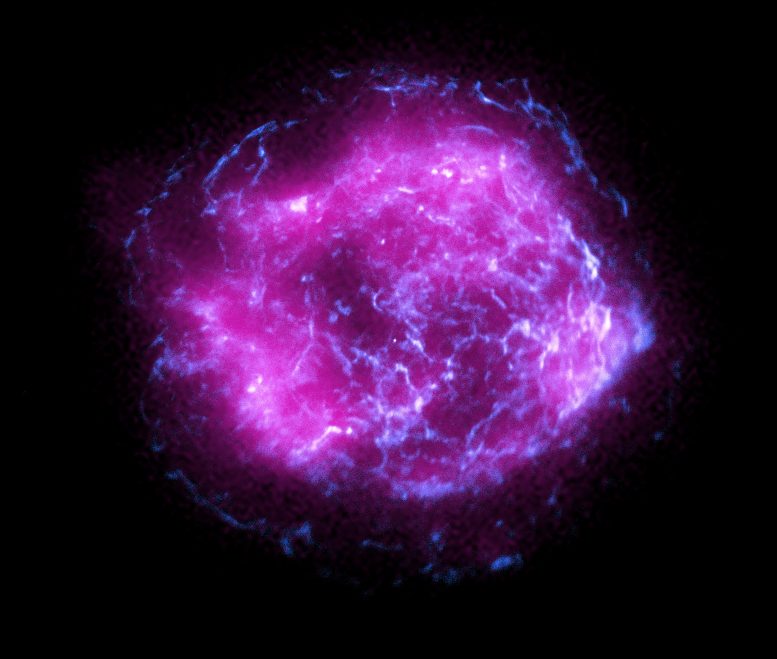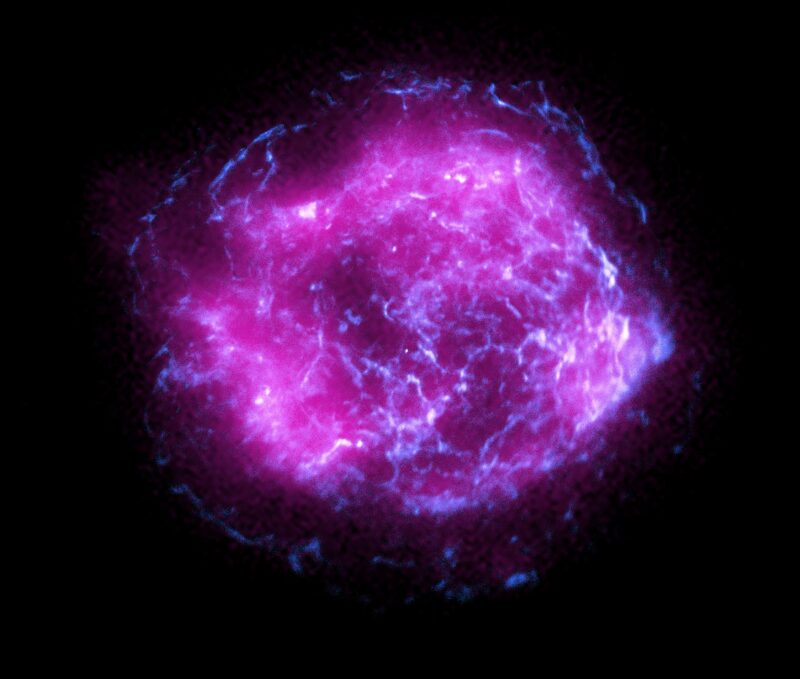
Cette image du vestige de supernova Cassiopée A combine certaines des premières données de rayons X collectées par l’Imaging X-ray Polarimetry Explorer de la NASA, en magenta, avec les données de rayons X à haute énergie de l’Observatoire Chandra X-Ray de la NASA, en bleu. Crédit : NASA/CXC/SAO/IXPE
C’est la première lumière pour l’un des plus récents observatoires spatiaux ! L’équipe de l’Imaging X-Ray Polarimetry Explorer a publié sa première image, prise après une phase de mise en service d’un mois pour le vaisseau spatial. Et c’est une beauté.
L’IXPE a observé une cible favorite des observatoires spatiaux, le vestige de supernova Cassiopée A. Alors que les rayons X sont invisibles à l’œil humain, la quantité de couleur magenta dans cette image correspond à l’intensité de la lumière X observée. Inutile de dire que les rayons X de haute énergie sont intenses.
Pour le contraste, l’équipe a superposé les observations d’un autre observatoire de rayons X, le Chandra X-Ray Observatory, qui apparaît sous forme de veines bleues dans l’image. Chandra et l’IXPE possèdent différents types de détecteurs, et capturent donc différents niveaux de résolution angulaire, ou de netteté. Ensemble, ils peuvent produire des données plus complètes et détaillées sur les sources de haute énergie dans l’Univers.
L’image est également un clin d’œil au vénérable observatoire Chandra, puisque Cas A a été la première image lumineuse de Chandra, également. Cette mission a été lancée en 1999 sous le nom de ;” data-gt-translate-attributes=”[{” attribute=””>NASA’s flagship mission for X-ray astronomy, and is still operating in a high Earth orbit.

This image from NASA’s Imaging X-ray Polarimetry Explorer maps the intensity of X-rays coming from the observatory’s first target, the supernova remnant Cassiopeia A. Colors ranging from cool purple and blue to red and hot white correspond with the increasing brightness of the X-rays. The image was created using X-ray data collected by IXPE between January 11-18. Credit: NASA
Since Earth’s atmosphere absorbs the vast majority of X-rays, they are not detectable from Earth-based telescopes. Space-based x-ray telescopes have allowed for new discoveries and new understandings of our cosmos.
This new image from IXPE contains data collected from January 11-18. The mission launched on December 9, 2021, on board a SpaceX Falcon 9 rocket from NASA’s Kennedy Space Center in Florida. IXPE was placed in an orbit around Earth’s equator at an altitude of approximately 372 miles (600 kilometers).
IXPE is a joint effort between NASA and the Italian Space Agency, and is the first space observatory dedicated to measuring the polarization of X-rays from some of the most fascinating and dynamic objects in the universe.
The team said all instruments are functioning well aboard the observatory, which is on a quest to study some of the most mysterious and extreme objects in the universe.

NASA’s Imaging X-ray Polarimetry Explorer (IXPE) mission is the first satellite dedicated to measuring the polarization of X-rays from a variety of cosmic sources, such as black holes and neutron stars. Credit: NASA
Cassiopeia A is the shredded remains of a star that exploded several thousand years ago. It is the youngest known supernova remnant in our Milky Way Galaxy and resides 10,000 light-years away in the constellation Cassiopeia, so the star actually blew up 10,000 years before the light reached Earth in the late 1600s.
The shock waves from the explosion have swept up surrounding gas, heating it to high temperatures and accelerating cosmic ray particles to make a cloud that glows in X-ray light. Other telescopes have studied Cassiopeia A before, but IXPE will allow researchers to examine it in a new way. The team is currently analyzing all the data to learn more, according to Martin C. Weisskopf, the IXPE principal investigator, in a press release.
For example, IXPE will allow scientists to see, for the first time, how the amount of polarization varies across the supernova remnant, which is about 10 light-years in diameter.
“IXPE’s future polarization images should unveil the mechanisms at the heart of this famous cosmic accelerator,” said Roger Romani, an IXPE co-investigator at Stanford University. “To fill in some of those details, we’ve developed a way to make IXPE’s measurements even more precise using machine learning techniques. We’re looking forward to what we’ll find as we analyze all the data.”
Originally published on Universe Today.



